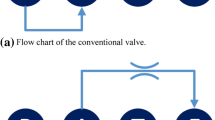Abstract
Fluid power regulation elements play a fundamental role in determining the characteristics of a servosystem. Valve is a critical component when deciding the overall performance, as it influences both running and transient conditions. It is hence important to correctly predict the performances of that component by an accurate numerical non linear model. The non linearities of the valve influence steady state accuracy of a system, especially in position servo systems. In the paper a methodology to test a pneumatic open loop proportional valve, with the description of the test bench and of the experimental scheme to measure the interested magnitudes, is presented. Results of the experimental activities, both in static and dynamic conditions, are reported, with particular attention to the flow magnitude, pressures and spool displacement. The analysis of the experimental data points out the non linearities of the system and the strong influence of force disturbances on the displacement of the spool, which works in open loop. The outcome of the experimental investigation allows to relate the input/output magnitudes in a graphical way, using a map of the data and to develop static and dynamic models for computer simulation, mechatronic design and control algorithm.















Similar content being viewed by others
References
Sorli M, Pastorelli S, Hydraulic and pneumatic actuation systems. In Bishop RH (ed) The Mechatronics Handbook. CRC Press, Boca Raton, pp. 20–62 20–96
Sorli M, Figliolini G, Pastorelli S (2004) Dynamic model and experimental investigation of a pneumatic proportional pressure valve. IEEE/ASME Trans Mech 9(1):78–86
Belforte G, Sorli M, Gastaldi L (1997) Active orthosis for rehabilitation and passive exercise. In: 4th International Conference on simulation in biomedicine: computational mechanics, Perugia, 1997. pp. 199–208
Sacco K, Cauda F, D’Agata F et al (2011) A combined robotic and cognitive training for locomotor rehabilitation: evidences of cerebral functional reorganization in two chronic traumatic brain injured patients. Front Human Neurosci 5: doi: 10.3389/fnhum.2011.00146
Fischer G, Iordachita I, Csoma C, Tokuday J, Mewesy P, Tempanyy C, Hatay N, Fichtingerz G (2008) Pneumatically operated MRI-compatible needle placement robot for prostate interventions. In: 2008 I.E. international conference on robotics and automation
Bruni S, Vinolas J, Berg M, Polach O, Stichel S (2011) Modelling of suspension components in a rail vehicle dynamics context. Veh Syst Dyn 49(7):1021–1072
Jacazio G, Gastaldi L (2009) An autonomous pneumotronic system for enhancing the braking capability of long freight trains. In Proc.ASME Dynamic Systems and Control Conference 2009, DSCC2009
Hodgsona S, Leb M, Tavakolia M, Phamb MT (2012) Improved tracking and switching performance of an electro-pneumatic positioning system. Mechatronics 22:1–12
Sorli M, Gastaldi L (2009) Thermic influence on the dynamics of pneumatic servosystems. J Dyn Syst Meas Control 131(2):1–5
Falcão Carneiro J, de Almeida GF (2013) Using two servovalves to improve pneumatic force control in industrial cylinders. Int J Adv Manuf Technol 66:283–301
Saleem A, Wong CB, Pu J, Moore PR (2009) Mixed-reality environment for frictional parameters identification in servo-pneumatic system. Simul Model Pract Theory 17(10):1575–1586
Krivts IL (2004) Optimization of performance characteristics of electropneumatic (two-stage) servo valve. J Dyn Syst Meas Control 126:416–420
Miyajima T, Sakaki K, Shibukawa T, Fujita T, Kawashima K, Kagawa T (2004) Development of pneumatic high precise position controllable servo valve. In Proc. IEEE Int. Conf. on Control Applications
Virvalo T (2001) The influence of servo valve size on the performance of a pneumatic position servo. In Proc 5th Int, Conf. On Fluid Power Transmission and Control ICEP
Yin YB, Araki K (1998) Modelling and analysis of an asymmetric valve-controlled single-acting cylinder of a pneumatic force control system. In proc.SICE, pp.1099–1104
Mehmood A, Laghrouche S, El Bagdouri M (2013) Nonlinear dynamic modeling of an electro-pneumatic pressure converter for VGT pneumatic actuator. Int J Automot Technol 14(6):941–953
Falcão Carneiro J, Gomes de Almeida F (2011) Pneumatic servovalve models based on artificial neural networks. Proc Inst Mech Eng Part I 225(3):393–411
Richard E, Scavarda S (1996) Comparison between linear and nonlinear control of an electropneumatic servodrive. ASME J Dyn Syst Meas Control 118(2):245–252
Thomasset D, Scavarda S, Sesmat S, Belgharbi M (1999) Analytical model of the flow stage of a pneumatic servodistributor for simulation and nonlinear control. In: Proc. of the Sixth Scandinavian International Conference on Fluid PowerTampere, Finland, May 26–28 1999: 848–860
Author information
Authors and Affiliations
Corresponding author
Rights and permissions
About this article
Cite this article
Gastaldi, L., Pastorelli, S. & Sorli, M. Static and Dynamic Experimental Investigation of a Pneumatic Open Loop Proportional Valve. Exp Tech 40, 1377–1385 (2016). https://doi.org/10.1007/s40799-016-0142-5
Received:
Accepted:
Published:
Issue Date:
DOI: https://doi.org/10.1007/s40799-016-0142-5




